Full moon names 2024 (and how they came to be)
The full moon names for each month, why they're named so and what we can expect from these lunar events.
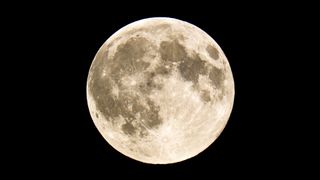
- Jan. 25: Full Wolf Moon
- Feb. 24: Full Snow Moon
- March 25: Full Worm Moon
- April 23: Full Pink Moon
- May 23: Full Flower Moon
- June 21: Full Strawberry Moon
- July 21: Full Buck Moon
- Aug. 19: Full Sturgeon Moon
- Sept. 17: Full Harvest Moon
- Oct. 17: Full Hunter's Moon
- Nov. 15: Full Beaver Moon
- Dec. 15: Full Cold Moon
- Lunar cycles
Many full moon names date back to Native Americans, of what is now the northern and eastern United States.
Those tribes of a few hundred years ago kept track of the seasons by giving distinctive names to each recurring full moon as the lunar cycle was an important method of timekeeping. Their names were applied to the entire month in which each occurred.
To be sure, there were some variations in the moon names, but in general, the same ones were current throughout the Algonquin tribes from New England to Lake Superior. European settlers followed their own customs and created some of their own names.
Why do full moons have names?
Full moon names are rooted in ancient traditions often from Native American, European or other cultural lore. The names often reflect natural events such as animal behavior or seasonal changes.
What is the most famous full moon?
The most well-known full moon is likely the "Harvest Moon" which is the closest full moon to the Autumn Equinox, it can fall in either September or October.

Joe Rao is Space.com's skywatching columnist, as well as a veteran meteorologist and eclipse chaser who also serves as an instructor and guest lecturer at New York's Hayden Planetarium.
Since the lunar ("synodic") month is roughly 29.5 days in length on average, the dates of the full moon shift from year to year.
Here is a listing of all the full moon names, as well as the dates and times (for the Eastern time zone) for the next twelve months.
Jan. 25: Full Wolf Moon
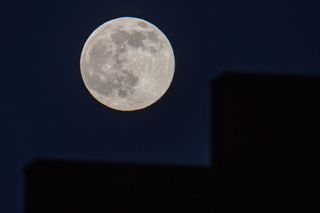
Jan. 25 at 12:54 p.m. EST (1754 GMT)
Amid the zero cold and deep snows of midwinter, the wolf packs howled outside Indian villages. It was also known as the Old Moon or the Moon After Yule.
According to the Farmer's Almanac, other names associated with the January full moon are the Cold Moon (Cree), Center Moon (Assiniboine), Canada Goose Moon (Tlingit) to name but a few.
Feb. 24: Full Snow Moon
Feb. 24 at 7:30 a.m. EST (1230 GMT)
Usually, the heaviest snows fall in this month. Hunting became very difficult, and hence to some tribes, this was the Full Hunger Moon or Hungry Moon.
Alternative names for the February full moon include the Bear Moon (Ojibwe), Bald Eagle Moon (Cree), and Month of the Bony Moon (Cherokee) to name but a few, according to the Farmer's Almanac.
March 25: Full Worm Moon
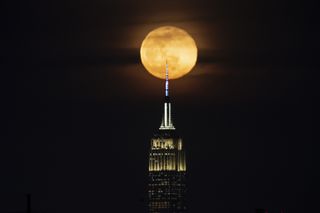
March 25 at 3:00 a.m. EST (0700 GMT)
In this month the ground softens and the earthworm casts reappear, inviting the return of the robins. The more northern tribes knew this as the Full Crow Moon, when the cawing of crows signals the end of winter, or the Full Crust Moon because the snow cover becomes crusted from thawing by day and freezing at night. The Full Sap Moon, marking the time of tapping maple trees, is another variation.
April 23: Full Pink Moon
April 23 at 7:49 p.m. EDT (2349 GMT)
The grass pink or wild ground phlox is one of the earliest widespread flowers of the spring. Other names were the Full Sprouting Grass Moon, the Egg Moon, and — among coastal tribes — the Full Fish Moon, when the shad came upstream to spawn. This is also the first full moon of spring — the so-called Paschal Moon.
May 23: Full Flower Moon
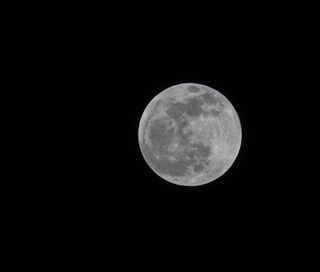
May 23 at 9:53 a.m. EDT (1353 GMT)
Flowers are abundant everywhere. It was also known as the Full Corn Planting Moon or the Milk Moon.
June 21: Full Strawberry Moon
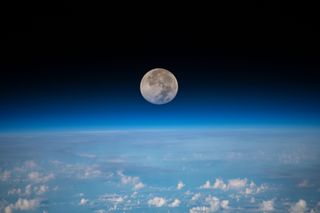
June 21 at 9:08 p.m. EDT (0108 GMT on June 22)
June was the time to harvest the ripening strawberries hence the name Strawberry Moon, known to every Algonquin tribe.
According to the Farmer's Almanac, it was also known as the Berries Ripen Moon (Haida), Birth Moon (Tlingit), Green Corn Moon (Cherokee) and the Hatching Moon (Cree) to name but a few.
July 21: Full Buck Moon
July 21 at 6:17 a.m. EDT (10:17 GMT)
The Full Buck Moon occurs when the new antlers of buck deer push out from their foreheads in coatings of velvety fur. It was also often called the Full Thunder Moon, thunderstorms being now most frequent. Sometimes also called the Full Hay Moon.
Aug. 19: Full Sturgeon Moon

Aug. 19 at 2:26 p.m. EDT (1826 GMT)
The Sturgeon Moon, when this large fish of the Great Lakes and other major bodies of water like Lake Champlain is most readily caught. A few tribes knew it as the Full Red Moon because the moon rises looking reddish through sultry haze, or the Green Corn Moon or Grain Moon.
Sept. 17: Full Harvest Moon
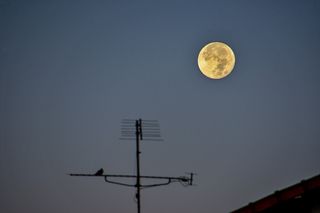
Sept. 17 at 10:34 p.m. EDT (0234 on Sept. 18)
Traditionally, this designation goes to the full moon that occurs closest to the Autumnal (Fall) Equinox. In most years, the Harvest Moon comes in September, but about every four or five years it occurs in October (next time this will happen will be in 2025). At the peak of the harvest, farmers can work into the night by the light of this moon.
Usually, the full moon rises an average of 50 minutes later each night, but for the few nights around the Harvest Moon, the moon seems to rise at nearly the same time each night: just 25 to 30 minutes later across the U.S., and only 10 to 20 minutes later for much of Canada and Europe. Corn, pumpkins, squash, beans, and wild rice — the chief Native American staples — are now ready for gathering.
Oct. 17: Full Hunter's Moon
Oct. 17 at 7:26 a.m. EDT (11:26 GMT)
With the leaves falling and the deer fattened, it is time to hunt. Since the fields have been reaped, hunters can ride over the stubble, and can more easily see the fox, also other animals that have come out to glean and can be caught for a Thanksgiving banquet after the harvest.
Nov. 15: Full Beaver Moon
Nov. 15 at 4:29 p.m. EST (2129 GMT)
Some accounts suggest the name Beaver Moon came from the fact that this moon signaled it was time to set beaver traps before the swamps froze to ensure a supply of warm winter furs! Another interpretation suggests that the name Beaver Full Moon comes from the fact that the beavers are now active in their preparation for winter. Also called the Frost Moon (Cree, Assiniboine), Freezing Moon (Anishinaabe), Digging/Scratching Moon (Tlingit) according to the Farmer's Almanac.
Dec. 15: Full Cold Moon
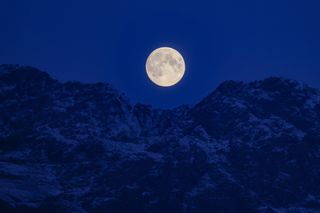
Dec. 15 at 4:02 a.m. EST (09:02 GMT)
The Full Cold Moon; among some tribes, the Full Long Nights Moon. In this month the winter cold fastens its grip, and the nights are at their longest and darkest. Also sometimes called the Moon before Yule (Yule is Christmas, and this time the moon is only just after it; the next full moon that falls on Christmas Day will come in 2034).
The term Long Night Moon is a doubly appropriate name because the midwinter night is indeed long and the moon is above the horizon a long time. The midwinter full moon takes a high trajectory across the sky because it is opposite to the low sun.
Lunar cycles
Lastly, here are some interesting calendrical facts that famed astronomical calculator Jean Meeus has compiled concerning the phases of the moon. All are cyclical, the most noteworthy being the so-called Metonic Cycle that was independently discovered by the Greek astronomer Meton (born about 460 B.C.). This is a 19-year cycle, after which time the phases of the moon are repeated on the same days of the year, or approximately so. For instance, there is a full moon on Aug. 1, 2023. Nineteen years hence, in 2042 there'll be another full moon on Aug. 1.
Another interesting cycle: after two years, the preceding lunar phase occurs on, or very nearly the same calendar date. Thus, in 2025, the First Quarter Moon will occur on Aug. 1. After eight years, the same lunar phases repeat, but occur one or two days later in the year. The Greeks called this eight-year cycle the octaeteris. Indeed, in 2031, a full moon occurs on Aug. 2.
Finally, in our Gregorian Calendar, 372 years provides an excellent long period cycle for the recurrence of a particular phase on a given date. Thus, we know with absolute certainty that the same full moon that shines down on us on Aug. 1 of 2023 will also be shining on Aug. 1 in the year 2395.
Mark your calendars!
Joe Rao serves as an instructor and guest lecturer at New York's Hayden Planetarium. He writes about astronomy for Natural History magazine, the Farmers' Almanac and other publications. Follow us on Twitter @Spacedotcom and on Facebook.
Join our Space Forums to keep talking space on the latest missions, night sky and more! And if you have a news tip, correction or comment, let us know at: community@space.com.
Get the Space.com Newsletter
Breaking space news, the latest updates on rocket launches, skywatching events and more!

Joe Rao is Space.com's skywatching columnist, as well as a veteran meteorologist and eclipse chaser who also serves as an instructor and guest lecturer at New York's Hayden Planetarium. He writes about astronomy for Natural History magazine, the Farmers' Almanac and other publications. Joe is an 8-time Emmy-nominated meteorologist who served the Putnam Valley region of New York for over 21 years. You can find him on Twitter and YouTube tracking lunar and solar eclipses, meteor showers and more. To find out Joe's latest project, visit him on Twitter.
-
Truthseeker007 Wow! Now they are naming them.lol! I like the idea of using a Native American custom.Reply -
Momatomic I. too like the Native American customs. They meant something important, and none of their names were frivolous. There is nothing new under the sun. All things merely await our recognition of their significance.Reply -
Daveland3D In the section on The Pink Moon, April 23 you wrote:Reply
“Ecclesiastical rules mandate that the first Sunday after this moon is Easter, and so it will be on the 9th.”
However, the first Sunday after this moon is actually April 28.
May 9th is not even a Sunday it’s a Thursday!
Not to mention that Easter Sunday already happened on March 31.
Can you please clarify?
Thanks. -
Daveland3D Reply
Unless that paragraph was meant for the preceding section on the Full Worm Moon, March 25?Daveland3D said:In the section on The Pink Moon, April 23 you wrote:
“Ecclesiastical rules mandate that the first Sunday after this moon is Easter, and so it will be on the 9th.”
However, the first Sunday after this moon is actually April 28.
May 9th is not even a Sunday it’s a Thursday!
Not to mention that Easter Sunday already happened on March 31.
Can you please clarify?
Thanks.
In which case Easter Sunday, March 31 would be the first Sunday after this full moon.